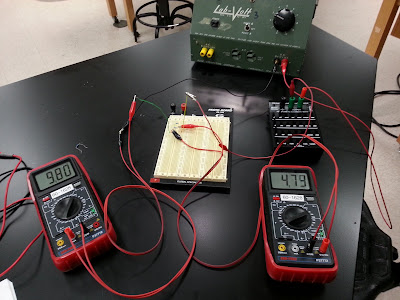We began by constructing the following circuit:
When the switch is closed, the base is provided with current and thus, current flows through the 2N3904 transistor and lights up the LED shown in the picture above.
The next demonstration is of the same circuit except it shows that the tip of our finger can be used to close the switch and power the transistor
The next part of the lab was to investigate the amount of current going into the base and coming out of the emitter. The circuit is built as follows:
We found the relationship of the current at A2 and at A1 by turning the linear potentiometer (P1). The results were:
The beta (gain) of the transistor is the ratio of the current coming out of the emitter and the current going into the base. The slope of this graph corresponds to the gain, whose value is 87.362.
















